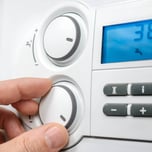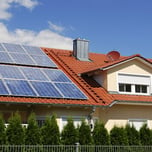Answer these simple questions and we will find you the BEST prices
Which type of solar quotes do you need?
It only takes 30 seconds
100% free with no obligation

Get up to 3 quotes by filling in only 1 quick form

Slash your energy bills by installing an energy efficient boiler

We’ve helped over 500,000 homeowners reduce their carbon footprint
- GreenMatch
- Boilers
- Smart Thermostats
The Potential of Smart Thermostats: A 2024 Perspective


Imagine being able to control your home's temperature with just a few taps on your smartphone or having a thermostat that learns your heating and cooling preferences to maximise energy efficiency - this is the job of a smart thermostat.
Unlike traditional thermostats, which only have a few functions, smart thermostats offer a new way to heat your home. Smart thermostats have revolutionised how we manage our home's climate, offering convenience, comfort, and significant energy savings.
In this comprehensive guide, we'll explore what smart thermostats are, how they work, and which models stand out as the best options for homeowners upgrading their heating systems. Whether you're tech-savvy or simply looking to streamline your home's energy usage, this guide will help you make an informed decision about integrating a smart thermostat into your living space.
- What makes a thermostat "smart"?
- The benefits of upgrading to a smart thermostat
- The best smart thermostats on the market
- How do smart thermostats work?
- Smart thermostat installation and setup
- Selecting the right smart thermostat
- Troubleshooting and maintenance
- The future of smart thermostats
- Frequently asked questions
What makes a thermostat "smart"?
Smart thermostats are a significant leap forward from traditional thermostats in functionality, convenience, and energy efficiency. Unlike their conventional counterparts, smart thermostats are equipped with advanced technology for precise control over a home's heating system.
The "smart" in smart thermostats comes from their ability to learn from your behaviour, adjust settings automatically, and be controlled remotely via smartphones or other connected devices. The technology used in a smart thermostat includes wifi connectivity and unique sensors.
Wi-Fi connectivity
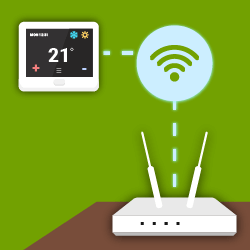
One of the defining features of smart thermostats is their Wi-Fi connectivity, which enables seamless communication with your home's network and allows you to control the thermostat from anywhere with an internet connection. This means you can adjust the temperature, create heating schedules, and monitor energy usage remotely, providing convenience and flexibility.
Sensor usage
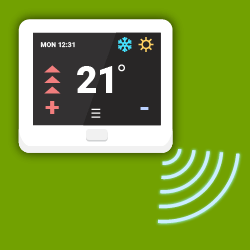
Smart thermostats use a range of sensors to gather data and optimise heating and cooling settings. These sensors can include occupancy sensors to detect when someone is home, ambient temperature sensors to measure the temperature in different areas, and humidity sensors to ensure optimal comfort levels. By leveraging this data, smart thermostats can make real-time adjustments to maintain a comfortable environment while minimising energy waste.
These smart technologies can offer homeowners precise control over their climate and energy usage. This level of automation and customisation sets smart thermostats apart from traditional models, making them a valuable addition to any modern home.
The benefits of upgrading to a smart thermostat
Upgrading to a smart thermostat is more than just a convenience – it’s an investment that can benefit homeowners. Changing how you control your home heating can lead to savings and a reduced environmental footprint, making it worth considering.
Below are some of the key advantages of making the switch to a smart thermostat.
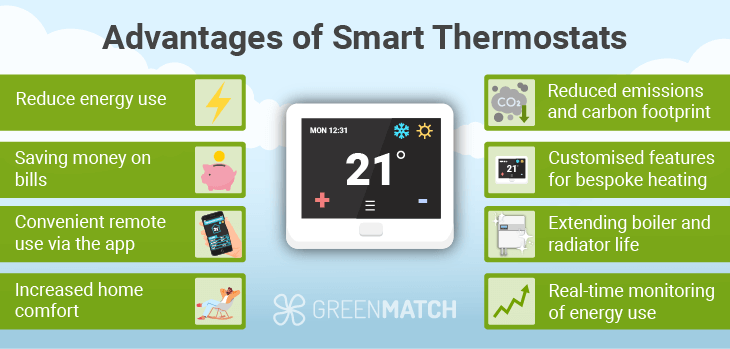
Energy efficiency and cost savings
Smart thermostats are designed to optimise energy use by learning your heating patterns and making automatic adjustments to minimise waste. With features like adaptive learning and geofencing (which can adjust temperatures depending on your home's location), smart thermostats can intelligently regulate your home's climate.
Using energy more efficiently can lead to reduced energy bills. It's been estimated that, on average, for every 1℃ decrease in temperature from your thermostat, you could save up to £130. This can differ depending on various factors, such as the specific smart thermostat model used, energy usage habits, and energy cost at any given time. It is widely thought, however, that smart thermostats can offer saving potentials between £150 to £600 per year, or up to 23% of your home's annual energy bill.
The savings from using a smart thermostat can lead to a significant return on investment, offsetting the initial purchase cost. In addition, utility companies may offer rebates or incentives for installing energy-efficient devices like smart thermostats, enhancing their cost-effectiveness.
Convenience and comfort
Beyond energy-related benefits, smart thermostats offer new levels of convenience and comfort. Remotely controlling your home's temperature via an app can contribute to a more manageable routine. This means you can maintain your heating from anywhere, giving you greater flexibility and awareness of your home heating use.
This is further enhanced if you have a home assistant, such as Alexa, Apple HomeKit or Google Home, as they can often be integrated with your smart thermostat. This can allow you to activate, schedule, or control your environment with your voice.
Environmental impact
Reducing energy consumption not only benefits you financially but also has a positive impact on the environment. Smart thermostats are crucial in minimising carbon emissions and overall energy usage, contributing to a greener, more sustainable future.
Smart thermostats often come with zoning features, allowing you to control the temperature in each room individually. This is a massive advantage over traditional thermostats, as it will enable you to monitor your energy use closely and helps reduce carbon emissions by avoiding unnecessarily burning fuels to heat rooms.
The best smart thermostats on the market
If you’re considering upgrading your thermostat, you might wonder which is the best model for your home. With an array of advanced features and controls, choosing the right smart thermostat can be a daunting task.
To help you navigate the options, we’ve looked into the top smart thermostat models available this year. We’ve listed their attributes and included key factors when selecting the ideal one for your needs.
Top models of 2024
| Model | Customer Reviews | Average Unit Cost (£) | Cost Including Installation* |
|---|---|---|---|
| Google Nest Learning Thermostat 3rd Generation | 4.5 / 5 star (8,021 reviews) | £189 - £220 | £310 - £340 |
| Tado Smart Thermostat V3+ | 4.5 / 5 star (1,901 reviews) | £140 - £200 | £140 - £200 (self-install only) |
| Hive Thermostat Mini | 4.3 / 5 star (151 reviews) | £80 | £250 - £280 |
| Honeywell Home T6 | 4.3 / 5 star (1,961 reviews) | £170 - £180 | £290 - £300 |
| Wiser Multi-Zone Smart Thermostat (Drayton) | 4.2 / 5 star (1,679 reviews) | £150 - £250 (subscription options available from £5.99/month) | £270 - £370 |
1. Google Nest Learning Thermostat
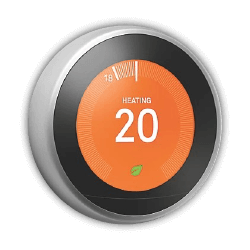
The Google Nest thermostat range is a highly recognised and rated smart thermostat. They offer two models, the ‘Learning’ and the ‘E’ thermostat. The Learning Thermostat is widely recommended for its intelligent habit learning and adaptability to your routine.
Google claims the Nest Learning Thermostat saves 10% to 12% on heating. This is achieved through clever features such as geolocation and automatic scheduling, which can control your temperature and heating use for you. For example, if you leave the house, you can turn down the heat to avoid energy waste.
A professional should install This smart thermostat, which connects directly to your boiler to control heating and hot water. Nest Learning also features a green leaf symbol that will indicate when your temperature is the most energy efficient, helping you recognise the ideal settings for your home.
This smart thermostat is recognised for its user-friendly interface and seamless integration with other smart home technologies - such as Alexa and Google Home, giving you even greater control.
| Key Features | Prices* |
|---|---|
| - Learning capabilities / auto-adapt - Works with Alexa and Google Home - Apps for iOS and Android - Geofencing/geolocation - Sleek, modern design - Energy saving ‘leaf’ - Frost protection - Multi-zone options - Holiday mode - Temperature and hot water control | Approx. £219 - £300 (high-end if professionally installed) |
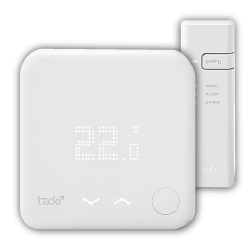
2. Tado Smart Thermostat V3+
The V3+ from Tado is a widely recommended smart thermostat. It has endless features that help you maximise your home heating and energy use.
Considered to be the best alternative to big brands, Nest and Hive, it’s a fierce competitor with a performance to match.
Arguably the simplest thermostat to install yourself, this kit has easy-to-follow instructions and quick, clear instruction videos to support you. This also means no need to pay extra for professional installation, as it’s made as easy as possible to do it yourself.
The thermostat has optional multi-zone heating, GPS location tracking and learning capabilities. It also features ‘open window detection’ and frost protection to ensure your system is well protected, and energy waste is eliminated.
Control is via the tado° app and can work with Alexa and Google Home. This thermostat has an auto-subscription that gives you detailed energy insights and reports. This also includes the Care & Protect package, which can identify any problems within your heating system, so be sure to check those details when purchasing to avoid any surprise fees.
| Key Features | Prices* |
|---|---|
| - Hot water control - Geolocation / GPS - Holiday mode - Open window detection - Weather forecasts - Frost protection - Multi-zone options | Approx. £100 - £200 Versions Wireless £199.00 Wired £179.00 Additional costs: Auto-Assist (Care & Protect) approx. £2.99 per month |
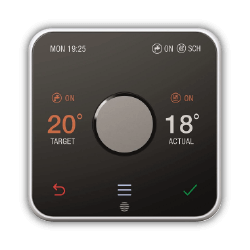
3. Hive Thermostat Mini
Hive is a very well-recognised brand of smart thermostats. They are partners with British Gas, meaning Hive product customers benefit from installation and maintenance directly from British Gas engineers.
The Hive Mini Thermostat model was awarded The Which? Best Buy in 2023 and is highly regarded amongst consumers. It has a sleek design and a wide range of smart features.
This small but mighty thermostat offers geolocation, holiday mode and frost protection to adapt to your schedule and environment. Hive claims that their Thermostat Mini can save you up to £311 per year through its adaptive and learning capabilities.
You can also enjoy integration with Alexa, Google Assistant, Apple HomeKit and Siri shortcuts. Hive Mini will also know if you leave the house, with geolocation or door sensors, and alert you or automatically turn your heating off when you leave.
This smart thermostat offers a lot of features at a reasonable price and is available to purchase from multiple retailers online. It also allows you to self-install or pay for a professional set-up.
| Key Features | Prices* |
|---|---|
| - GPS/Geolocation - Frost protection - Hot water control - Door sensors (optional extra) - Voice control via Alexa, Google, Apple and Siri - Compatible with most systems - Self-install or Professional option - Multi-zone options - Holiday mode | Approx. £80 - £280 (higher end if professionally installed) Additional costs: Optional subscription to Hive Heating Plus for budgets, insights, and system performance monitoring. £3.99/month or £29.99/year |
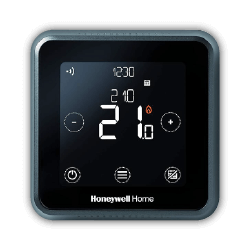
4. Honeywell Home T6
Honeywell Home is one of the leading brands for home heating controls in the UK, and they deliver a smart thermostat that’s highly regarded for its features.
The Honeywell T6 has adaptive capabilities, making your home more energy-efficient while saving you time and money.
Through the Honeywell app, you can schedule or change settings remotely, no matter where you are. Geolocation also enables the thermostat to control your heating if you're away.
The thermostat itself features an intuitive touch screen, making control even easier. In addition, you can integrate other smart products with the Honeywell T6 to get the most out of your energy use.
| Key Features | Prices* |
|---|---|
| - Adaptive / learning capabilities - Touchscreen thermostat - Honeywell Home App (iOS and Android) - Geolocation - Up to 6 time settings per day - Compatible with Apple Homekit, Apple Watch, Google Home, Alexa and IFTTT | £170 - £300 (higher end if professionally installed) |
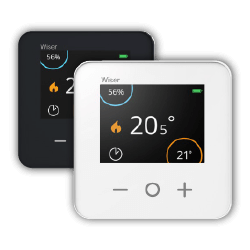
5. Wiser Smart Room Thermostat (Drayton by Schneider Electric)
Wiser is a smart room thermostat from Drayton. They offer whole home energy management products, with this smart thermostat forming part of a kit.
These kits are intended to give you more precise information and control over your home's heating and energy use.
Paired with the Wiser Home App, this thermostat allows you to check, set and boost your temperature in any heating zone. The wireless thermostat can pair with Wiser’s radiator valves to control specific radiator temperatures in different rooms.
Wiser also includes ‘Eco Mode’, which learns your home's temperature patterns to schedule your heating. They claim this smart learning can save you up to 2% on your annual heating bills. In addition, using their geofencing features could save up to 14% as it can also be connected to other smart elements in your home, such as smart light bulbs and plugs.
Currently, this system can be purchased outright or as a subscription package, with prices starting from £5.99/month. However, Wiser claims that their product can save you up to £440 per year in energy bills.
| Key Features | Prices* |
|---|---|
| - Learning capabilities - Energy-saving modes - Open window detection - Geofencing - Wiser Home App - Compatible with Alexa and Google - Humidity sensor - Insights and heat reports - Pair with other smart controls - smart plugs, radiator valves | Subscription: £5.99 - £8.49/month Purchase: £180 - £200 |
What to look for in a smart thermostat
When looking for a smart thermostat for your home, you need to consider some key features and compatibility details. Choosing the right components can impact whether the device is effective and can integrate with your existing systems.
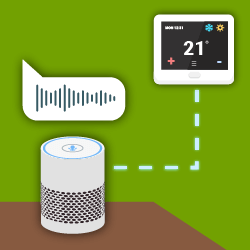
-
Compatibility
Ensure that the smart thermostat you’re interested in is compatible with your heating set-up - in particular, your type of boiler and central heating system. For example, can the thermostat provide hot water control if you have a system boiler that uses a hot water cylinder? Or is the device only compatible with combi boilers? Take particular care if you want to connect to a heat pump or other renewable heating system.
-
Connectivity and controls
Look for smart thermostats that integrate with popular smart home platforms and voice assistants like Amazon Alexa or Google Assistant - if this is important to you.
Most smart thermostats are primarily controlled through an app. If this doesn’t suit you, look for one that can be controlled from the thermostat or has website control capabilities (these will be limited in choice, though).
-
Installation
Many smart thermostats can be self-installed (some brands only offer this option!), so be sure to check before you purchase. In addition, those which need professional installation usually come with extra fees to account for.
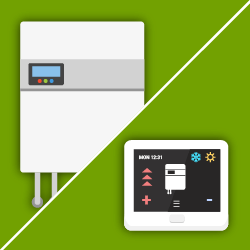
-
Boiler communication
Some thermostats can communicate directly with your boiler using a type of ‘language’. Each boiler may have a communication system, but the most common is OpenTherm.
OpenTherm is a system that allows your thermostat to adjust your boiler settings rather than simply turning it on or off. This means you get greater control and less energy waste. This precise control is called ‘modulation’ and is another term you may come across when looking for a smart thermostat.
If you want a more precise heating control from your thermostat, look out for these details.
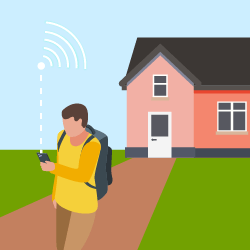
-
Features
A lot of jargon can be used to describe smart thermostats and their features. If there are some actions you particularly desire from your thermostat, be sure to find out what these may be termed as.
For example, geolocation is also called geofencing or GPS location. This is when a smart thermostat uses the GPS location of your phone to determine whether you are in the house - this is when some models will automatically turn down your heating or send you an alert.
Look out for some basic features like hot water control. This is usually only available on models that work with efficient boilers (or conventional boilers) which use an external hot water tank.
-
Reviews
It’s always recommended that you read other consumer’s product reviews. This is the best way to know before investing in a smart thermostat if it meets expectations.
Learning capabilities / adaptive algorithms: A thermostat can learn how you use your heating and apply schedules to suit your routine. It can also use weather reports to do this in some cases.
Smart home / Smart ecosystem: This can refer to a home that uses multiple ‘smart’ products, such as light bulbs, plugs, or radiator valves. They can usually work together and will reduce energy use. Many thermostat brands also offer these products and will likely advertise them together.
IFTTT: Stands for ‘If This Then That’. It is a platform which lets users connect apps and devices to automate tasks. It means a user can program one device to trigger an action or response to something else – with a thermostat, this could be ‘if the temperature drops below 16 degrees, turn on the heating’. Apple Shortcuts gives users a version of this, and it can be used to help set up smart devices around the house.
Multi-zone / zones / zonal heating: These refer to different areas of the house, or ‘zones’, which can be set at different temperatures. Usually, you will need multiple devices or sensors to set this up, but most smart thermostat apps can control these multiple zones.
Open window detection: This feature will notice any sudden drop in temperature and can alert you or turn off the heating. It doesn’t always mean a window is open – but it’s a good way to avoid accidentally heating a room with an open window!
Frost protection: This feature can recognise when temperatures are low enough to freeze your pipes. To stop any damage, it will turn up the heat to keep the water flowing through them warm and functioning properly.
How do smart thermostats work?
A smart thermostat uses sensors to monitor and control the temperature in a home. It connects to the heating and cooling systems and allows users to set and adjust the temperature remotely using a smartphone, tablet, or computer.
Smart thermostats can learn the user's behaviour and adjust the temperature settings automatically to save energy. Some can also provide energy usage reports and integrate with other smart home devices.
Below is a brief diagram of how to use a smart thermostat system.
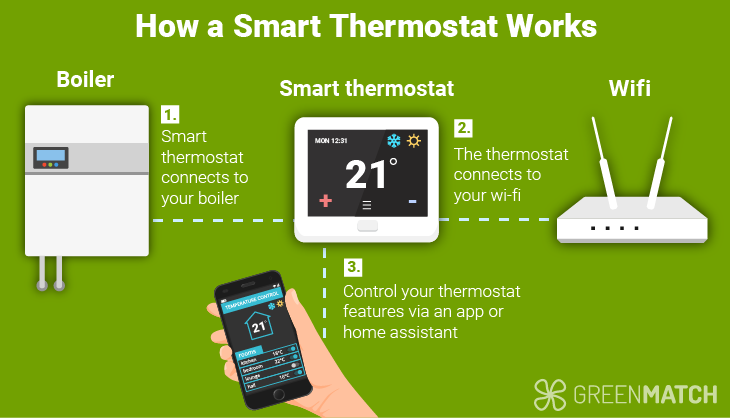
-
Upon installation, the smart thermostat learns your temperature preferences and daily routines through its sensors and algorithms.
-
Using a mobile app, homeowners can set a schedule for heating based on their typical daily activities, such as waking up, leaving for work, and returning home.
- Users can remotely control the thermostat via the app, which allows them to adjust their heating from wherever they may be. If you're at home, you can connect your smart thermostat to a voice assistant like Amazon's Alexa or Google's Assistant.
Smart thermostats use a combination of sensors, data analysis, and connectivity to manage home heating systems efficiently. These devices typically employ the following mechanisms:
Sensors and learning algorithms
Sensors gather home environment data, including temperature, humidity, occupancy, and ambient light. Advanced learning algorithms analyse this data to understand occupants' habits, schedule heating or cooling times, and optimise energy usage.
Connectivity and remote control
Smart thermostats often connect to Wi-Fi networks, allowing users to control and adjust the temperature remotely through dedicated mobile apps or voice assistants. This connectivity also enables the thermostat to receive software updates and integrate with other smart home devices.
Geofencing
Many smart thermostats feature geofencing technology, which uses the location of occupants' smartphones to determine when they are approaching or leaving home. This allows the thermostat to adjust the temperature settings accordingly, maximising energy efficiency.
Smart thermostat installation and setup
Proper installation and setup of a smart thermostat are crucial for optimising its performance and maximising energy efficiency in a home. You should follow some key tips and checks for a successful smart thermostat installation and setup.
Compatibility check:
1. Identify the heating system in your home, such as a system boiler, a combi or a heat pump. Ensure that the smart thermostat is compatible with your specific system type.
2. Check the existing wiring of your system and compare it with the compatibility requirements of the smart thermostat. Different thermostat models may require specific wiring configurations, and ensuring a match is essential.
3. Verify that the smart thermostat is designed to work with your system's voltage and power supply. Some thermostats may require a specific voltage range or a
C-wire for power.
If your current system lacks a C-wire, there are several methods to add one, including running a new wire inside the wall to the thermostat or using a surface-mounted conduit. Some thermostat manufacturers also offer C-wire adapters to add a C-wire to your system easily.
The C-wire, or common wire, is a low-voltage power wire that provides a continuous power flow to a thermostat. It is essential for properly functioning smart thermostats, as it ensures a stable power supply to support features such as Wi-Fi connectivity and touchscreen displays. Smart thermostats may experience issues such as unreliable Wi-Fi connections and excessive battery drain without a C-wire.
4. If your system includes additional components such as humidifiers, dehumidifiers, or ventilation systems, ensure that the smart thermostat supports the integration and control of these components.
To facilitate this process, many thermostat manufacturers provide online compatibility check tools or support resources to help homeowners determine whether a specific smart thermostat is suitable for their system.
Placement and setup:
- Choose a frequently used room, away from draughts and heat sources, with a clear view of the room.
- For zoned systems, install the thermostat in the zone it controls.
- Ensure it's within the wireless range of the heat sink (30m maximum).
- Mount the thermostat on the wall at 1.2 - 1.5 metres.
Step-by-Step installation guide
Most smart thermostats that require self-installation will come with a comprehensive guide suitable to that make and model. Check the manufacturer’s website or manual for complete guidance and safety information.
The guide below outlines what you might expect when installing a smart thermostat - although we suggest that you follow the guidance given with any specific model you purchase.
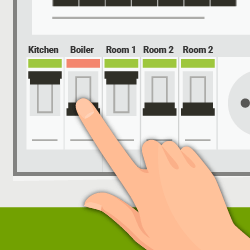
Step 1: Turn off the power.
Switch the power off to your boiler from the central fuse box to ensure safety during installation.
For new installations, Choose a location
You should place your thermostat on an interior wall, out of direct sunlight and any heating or cooling sources - as this can affect its performance. Ensure it is placed 1.2 - 1.5 metres from the floor.
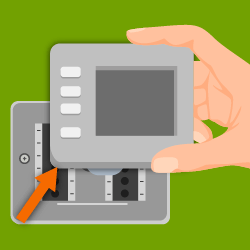
Step 2 Remove existing thermostat (for wired only)
Take the outer cover off of your existing thermostat and access the wiring. Take a picture of the wiring configuration for reference before disconnecting any wires. Some thermostat kits also come with stickers to ensure you keep track.
Have your new thermostat nearby for the next part!
Step 3 Disconnect the wires
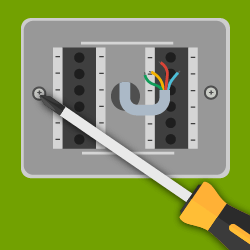
Disconnect the wires from your existing thermostat and take care to keep them from falling into any wall cavity.
Step 4 Connect the new thermostat
Next, feed the wires through your new thermostat. Then insert each wire into its corresponding terminal - this is when your thermostat manual and the photograph you took early come in handy!
Step 5 Install the thermostat display

Once you’re happy all the wires are correctly connected and any loose wire is pushed back into the wall, you can install the front display panel of your new thermostat.
This should connect and click into place.
Step 6 Turn on the power
Switch the main power back on at your fuse box. Your new thermostat should now be ready to go! Follow the instructions provided with your thermostat to connect it to your wi-fi and get ready to enjoy complete control of your heating.
If you encounter complications or are uncertain about any step, consider seeking professional assistance to ensure a safe and accurate installation.
Professional installation services
Professional installation of a smart thermostat may be necessary, particularly if you find yourself in any of the following circumstances:
- Complex heating system: If your system is complicated or unsure about compatibility, it's advisable to seek professional installation to ensure proper integration and functionality.
- Lack of wiring compatibility: Some older systems, such as a C-wire, may not have the necessary wiring for smart thermostat installation. A professional can assess the system and, if needed, install a C-wire to support the new thermostat.
- Safety concerns: If you are uncomfortable working with electrical components or have concerns about the safety of the installation process, it's best to hire a professional to avoid potential hazards.
You should compare services and quotes from multiple installers when seeking professional installation. This can ensure you find the best advice on a budget to suit you. Always choose a qualified installer and request quotes before you commit to anything.
Using our quick and easy service, we can connect you with up to 3 trusted professionals in your local area who can offer you free, no-obligation quotes. Click the link below to skip the hassle of searching for someone you can trust.
- Quotes from local engineers
- Payment by finance available
- Save up to £975
It only takes 30 seconds



Investing in professional installation can save you time and potential hassle, ensuring your smart thermostat operates efficiently and safely.
Selecting the right smart thermostat
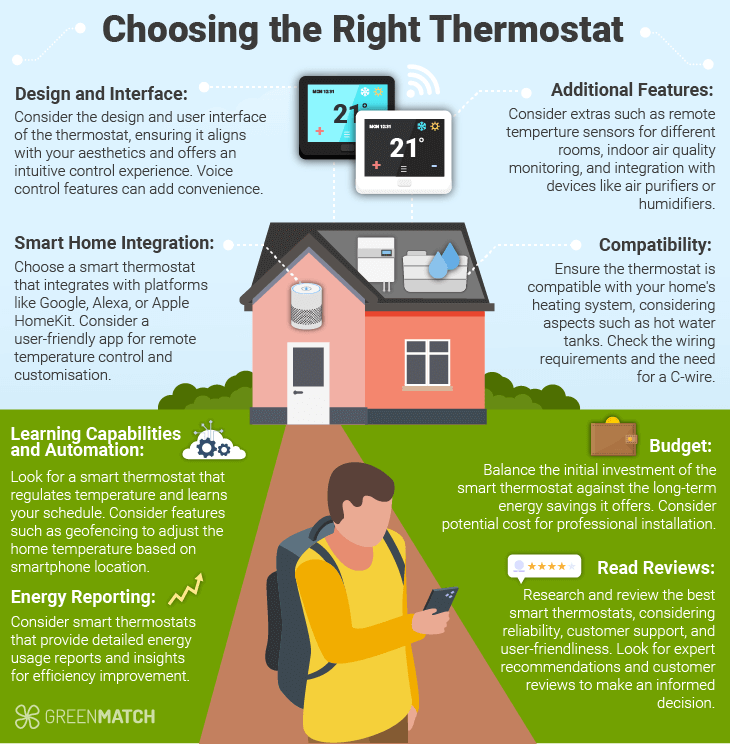
Troubleshooting and maintenance
Like any complex technology, while offering advanced features, smart thermostats can encounter issues. Here are some common problems users may encounter and how to troubleshoot them:
-
Connectivity Problems: If the smart thermostat loses its connection to the Wi-Fi network, try resetting the network settings and reconnecting. Ensure the thermostat is within range of the Wi-Fi router.
If the thermostat stops working, it could be due to dead batteries. Replace the batteries and ensure they are properly installed.
Check for notifications indicating a loss of power. This could be due to dead batteries, a blown fuse, or a tripped circuit breaker.
- Incorrect Temperature Reading: If the thermostat displays inaccurate temperature readings, recalibrate the device or check for any obstructions affecting the temperature sensor.
- Power or Wiring Issues: Check the power source and wiring connections if the thermostat is unresponsive. Ensure the C-wire is properly connected if required.
- Firmware Updates and Technical Support: Regularly check for firmware updates for your smart thermostat to ensure it has the latest features and security patches. Follow the manufacturer's instructions to perform updates.
If troubleshooting efforts prove unsuccessful, contact the manufacturer's technical support for guidance and assistance. They can provide troubleshooting steps and solutions for more complex issues.
If you encounter persistent connectivity issues, wiring complexities, or technical malfunctions that cannot be resolved through basic troubleshooting, consider seeking professional help from qualified technicians or the manufacturer's authorised service providers.
Professional heating installers can assist you with tasks such as recalibrating temperature sensors, addressing compatibility issues, or performing advanced diagnostic tests. To get the best support, it is recommended that you contact multiple installers to get advice and compare quotes.
Fill in the form in just 1 minute
The future of smart thermostats
Thermostats have already come a long way in assisting us to optimise the way we heat our homes, but what comes next? With rapid advances in technology, the landscape of smart thermostats could be set for significant evolution in the coming years.
The global smart thermostat market is anticipated to rise considerably, with a compound annual growth rate (CAGR) of 17.1% to 19.97% by 2028. This is driven by increasing demand for smart thermostats in residential, commercial, and industrial sectors and raising awareness for energy conservation and sustainable living.
New home automation system features and applications could change how we view smart heating technology. Let’s look at some of the predicted changes in the industry.
Innovations and trends
Advanced AI integration
Smart thermostats will increasingly incorporate sophisticated AI algorithms. These will enable the devices to learn more from user preferences, weather patterns, and local energy rates.
These changes will optimise temperature settings for both comfort and cost-effectiveness. However, integrating these advanced technologies may lead to an increase in the price of smart thermostat units.
Seamless integration
Future smart thermostats are expected to seamlessly integrate with other smart home devices such as lighting, blinds, and home security systems.
The increasing dependency on smartphones and mobile apps drives the demand for smart thermostats as part of an all-in-one smart home solution. This interconnected ‘ecosystem’ will enable holistic automation and enhanced energy management.
Energy source optimisation
As the UK moves towards more sustainable energy sources, smart thermostats will start to incorporate functionality that optimises the use of renewable energy, like solar or wind power, depending on availability and cost.
Reduced environmental impact
As a result of the increased adoption of this technology, there will be a greater shift towards reduced energy use. This will have a direct impact on the environment. As we use less energy, we can mitigate climate change.
The role of smart thermostats in smart cities
Smart thermostats are anticipated to play a key role in developing smart cities and modernising energy grids.
A ‘smart city' is a modern city that uses technology to improve things. This can include using sensors to manage traffic, improve public services, and make everything more environmentally friendly. The goal is to make the city a better place to live and work by using technology to solve everyday problems.
Using insights gained from homes using smart thermostats, a smart city or energy grid can adapt to peak energy consumption and put initiatives into place to alleviate stress on energy grids - such as adjusting heating temperatures or knowing when to divert to renewable stores during busy periods.
In conclusion, the future of smart thermostats is not just about individual comfort and convenience; it is intrinsically linked to the broader goals of energy efficiency, sustainability, and smart city development.
As technology continues to advance, these devices will become integral components in the smart ecosystems of the future, contributing significantly to both personal and collective energy management solutions.
Frequently asked questions
Using sensors, data analysis and wireless communication, they can understand a home’s environment and change the heating use depending on the user’s preference. Learn how smart thermostats work.
Saving money through reduced energy use is the biggest benefit. Controlling your heating through an app or voice command gives you greater control and convenience. There are many benefits to smart thermostats.
You can install them yourself or pay a professional to do it. Most top brands give you step-by-step installation instructions.
Nest Learning, Tado V3+ and the Hive Mini are all top thermostat models to consider. Each has unique features and price points. Find the best smart thermostats of 2024.
If you want to save money on bills and reduce carbon emissions, a smart thermostat can help! But you should weigh the benefits against your budget and know what to look for in a smart thermostat.

Becky is an experienced SEO content writer specialising in sustainability and renewable trends. Her background in broadcast journalism inspires reliable content to help readers live more sustainably every day.
We strive to connect our customers with the right product and supplier. Would you like to be part of GreenMatch?

- What makes a thermostat "smart"?
- The benefits of upgrading to a smart thermostat
- The best smart thermostats on the market
- How do smart thermostats work?
- Smart thermostat installation and setup
- Selecting the right smart thermostat
- Troubleshooting and maintenance
- The future of smart thermostats
- Frequently asked questions



